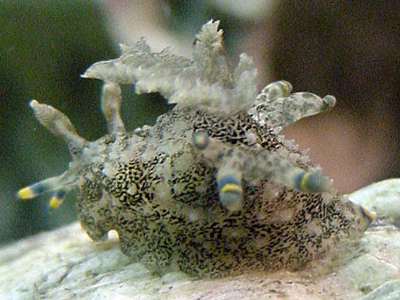
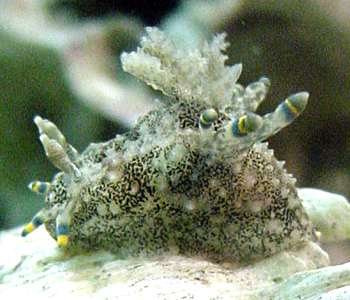
Polycera hummi
Abbott, 1952
Order: NUDIBRANCHIA
Suborder: DORIDINA
Superfamily: ANADORIDOIDEA
Family: Polyceridae
Subfamily: Polycerinae
DISTRIBUTION
Known from Florida and North Carolina - Atlantic coast of USA.
PHOTO
West coast of Florida [USA], near Tampa Bay, 1-2m deep. Approx 2cm long. Photo: Karen Mudgett
This species has the shape generally found in this genus, but has the following distingusihing features. There is no distinct notal edge separating the dorsal mantle from the sides of the body except for a series of elongate lateral papillae. Anteriorly there are two papillae on each side in front of the rhinophores, and posteriorly there are 3 or 4 papillae on each side, the anteriormost on each side being adjacent to the gill circle. These posterior papillae are often called 'extra-branchial processes'. Both the mantle and the sides of the body are covered in low conical pustules or papillae.
The background colour of the body is a translucent brownish grey, and all over the body is a close scattering of black or dark brown specks. The smaller conical papillae, gills and rhinophores are all translucent grey brown but the elongate lateral papillae have three characteristic colour bands - a subterminal blue band, followed by a yellow band and then another blue band about midway down each papilla.
This species was initially described from 5 preserved decolourised specimens from Alligator Harbour, Florida, but fortunately a living specimen from Alligator Harbour, and notes on living specimens from Beaufort, North Carolina, were made available to the author while he was preparing to publish his description. Without the 'additional notes' on the living animal, which is attached at the end of his description, this species would have been unidentifiable. This species has been rarely reported in the literature since its original description. Marcus (1961) describes anatomical details of a single specimen from Beaufort, Nth Carolina, and Eyster (1980) reports animals up to 22mm long and their egg masses from Georgetown County, Sth Carolina. They were on the arborescent bryozoan Bugula, which is most probably its food.
See the similarly coloured Polycera aurisula.
References:
• Abbott, R.T. (1952) 2 new opisthobranch mollusks from the Gulf of Mexico belonging to the genera Pleurobranchaea & Polycera. Florida State University Studies, No. 7. Papers from the Oceanographic Institute: 1-7, pls. 1,2. [Including: Additional notes on Polycera hummi.]
• Eyster, L. S. (1980) Distribution and reproduction of shell-less opisthobranchs from South Carolina. Bulletin of Marine Science, 30(3): 580-599.
• Marcus, Er. (1961) Opisthobranchia from North Carolina. Journal of the Elisha Mitchell Scientific Society, 77(2): 141-151
Rudman, W.B., 2004 (January 7) Polycera hummi Abbott, 1952. [In] Sea Slug Forum. Australian Museum, Sydney. Available from http://www.seaslugforum.net/find/polyhumm
Related messages
Polycera hummi from Gulf of Mexico
June 1, 2010
From: Kasey L. Grace
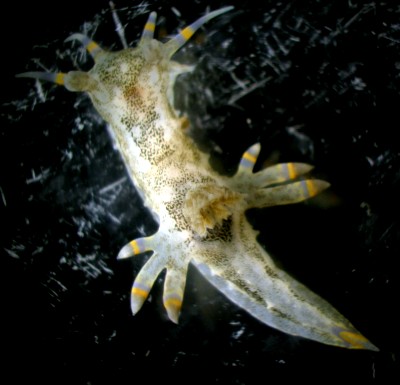
Hello Bill,
I found this specimen while trolling in a seagrass bed near Panacea, Florida. I believe that this is Polycera hummi from the photos posted. Measured ~14 mm long and 4 mm wide. I included some photos as well with an array of angles (whole specimen, mouth, underbelly, etc.)
Locality: Panacea, roughly 2 meters, Florida, USA, Gulf of Mexico, 24 May 2010, sea grass beds with sporadic sand patches. Length: 14 mm. Photographer: Kasey Grace.
Kasey Grace
kg08@fsu.edy
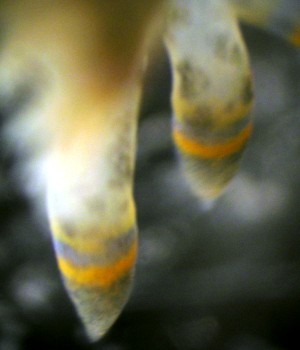
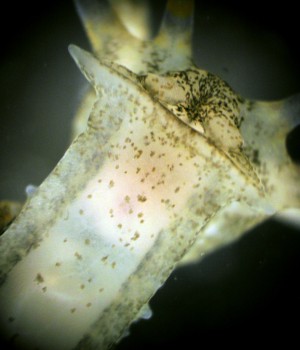
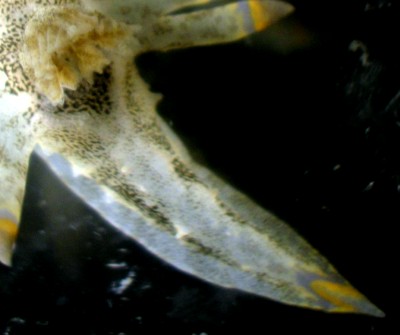
Dear Kasey,
Yes this is Polycera hummi. I can also see the rather characteristic V-shaped yellow mark on the tip of the 'tail', which in some animals is a raised spur-like structure.
Best wishes,
Bill Rudman
Polycera hummi from Mississippi, USA
November 21, 2007
From: Gretchen Grammer
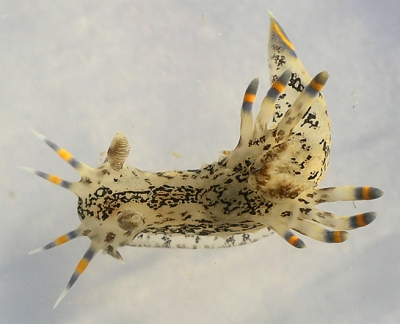
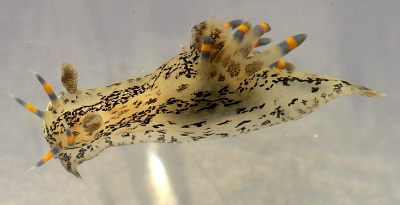
Dr. Rudman,
This sea slug was found on 8 Nov 2007 in the Grand Bay National Estuarine Research Reserve in Jackson County, Mississippi, USA on a floating mat of bryozoans while seining for fish. I think it is in the genus Polycera, and would greatly appreciate any help to identify it to species level.
Locality: Grand Bay National Estuarine Research Reserve, 0.5 m, Mississippi, USA, Gulf of Mexico, 08 November 2007, Erosional edge of natural saltmarsh in a bryozoan mat (muddy clay bottom). Length: 2.5 cm. Photographer: Gretchen Grammer.
Thanks!
Gretchen Grammer
gretchen.grammer@dmr.ms.gov
Grammer, G.L., 2007 (Nov 21) Polycera hummi from Mississippi, USA . [Message in] Sea Slug Forum. Australian Museum, Sydney. Available from http://www.seaslugforum.net/find/21151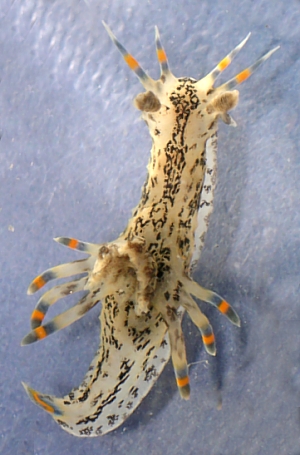
Dear Gretchen,
This is the west Atlantic species Polycera hummi. It is known from only a very few records from Nth Carolina and Florida so yours from Mississippi is a welcome addition. It give us a good idea of the colour pattern and the number of papillae arranged around the mantle edge. Since there are only about six known records of this species since its description in 1952, every new one helps build up a better picture of this species' shape and colour
Best wishes,
Bill Rudman
Re: Polycera hummi from North Carolina
December 6, 2006
From: Anthony Fernando
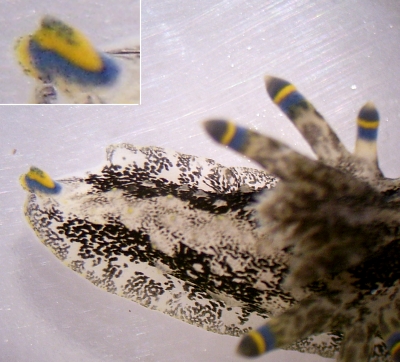
Concerning message #18476:
Hi Dr. Rudman,
I apologize for the delay, attached are pictures taken yesterday of the tail. What appeared to have been a notch is a segment of the tail without particular pigmentation. Photographer: Janet Hanson.
Tony Fernando
anthonyfernando@yahoo.com
Fernando, A.V., 2006 (Dec 6) Re: Polycera hummi from North Carolina. [Message in] Sea Slug Forum. Australian Museum, Sydney. Available from http://www.seaslugforum.net/find/18699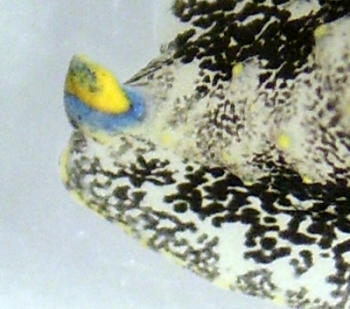
Thanks Tony,
What I was interested in finding out was whether there was a notch or a raised crest on the posterior tip of the foot. Since your earlier photos were all taken from directly above I couldn't be sure. Janet's photo show that there is indeed a raised crest. This is a very interesting structure as I can't think of another species of Polycera with such a feature.
Best wishes,
Bill Rudman
Polycera hummi from North Carolina
November 22, 2006
From: Tony Fernando
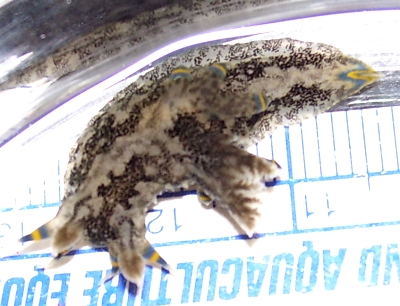
Hello Dr. Rudman,
Attached please find photos of our specimen of Polycera hummi. Collection was made during routine cleaning of an upweller receiving raw seawater from Bogue Sound.
Locality: Morehead City, collected in upweller, North Carolina, USA, Bogue Sound, 9 November 2006. Length: 25 mm. Photographer: Tony Fernando.
Unfortunately I didn't attempt to identify the animal until about a week after capture, so I lost the oportunity to do fecal assesment to determine it's food in the "wild". The animal is currently in isolation, and we will present it with local Bryozoan sp. to confirm the suspected feeding behavior.
I have requested the 1952 and 1980 papers which mention the animal (I already have the 1961 Marcus paper)... other than looking at laboratory feeding, off the top of your head is there anything else we should be looking at with this specimen?
Tony Fernando
anthonyfernando@yahoo.com
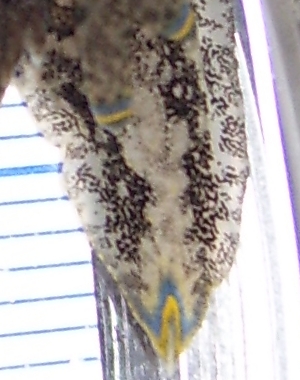
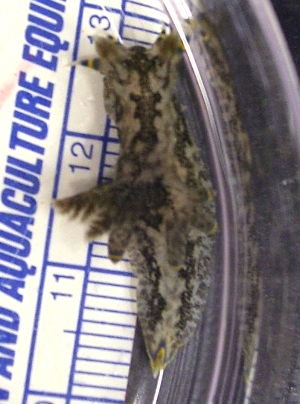
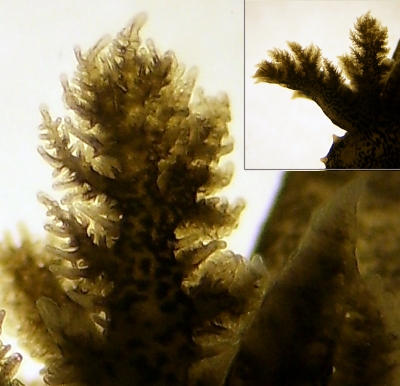
Dear Tony,
It's good to get another record of this species. It is apparently more common than the few records suggest. Every new record gives us a bit more information. For example, your photos show an interesting colour pattern at the posterior tip of the foot - and suggests there is a split or notch at the posterior tip. Is there really a notch there or is there a colourless crest - I can't see in the photos? Either way it is an interesting and unusual anatomical feature. I have added a close-up of the gill to show the secondary and tertiary branching.
I can't think offhand of any vital observations you would need to make, but what could be useful, since we know so little of this species, is to preserve the specimen as a voucher specimen in a natural history museum so that anyone revising the polycerids in the future can use it for comparative research. If you can do that it would be valuable to accompany the specimen with a set of your photos so that future researchers know exactly what colour their preserved animal had when it was alive. have a look at the preservation Fact Sheet.
Best wishes,
Bill Rudman
Re: Polycera hummi from Florida
July 11, 2004
From: Karen Mudgett
Dr Rudman,
I just wanted to give you an update on Polycera hummi [see message #11873]. Yesterday afternoon, [22 April 2004] around sunset, we went out to collect small grass shrimp for our tank. Instead of finding the shrimp, we found sea slugs, every scoop brought up two or three in our net. They were all small, about the same size as the ones we found previously, and all were Polycera hummi. There had to have been a mass gathering of them there for us to have scooped up as many as we did.
The depth of the water was between 1 and 2 feet deep, the bottom mostly mud, sandy in some areas, with what is commonly called eelgrass or turtle grass here. I have no idea what the scientific name would be for the grass. It was under a bridge only a few miles from where we found the other sea slugs in January.
With the other two, we tried to get food for them, brought home everything we found, watched to see what they might want, unfortunately I don't think we ever figured it out. So this time, even though we wanted to try again, we put all the sea slugs back where we found them and have decided that unless we find something different to take pictures of, we're not bringing any more home.
Again, thank you so much for everything,
Karen Mudgett
Anoksunamun@wildmail.com
Mudgett, K., 2004 (Jul 11) Re: Polycera hummi from Florida. [Message in] Sea Slug Forum. Australian Museum, Sydney. Available from http://www.seaslugforum.net/find/12645Thanks Karen,
Bill Rudman
Re: Polycera hummi from Florida
January 12, 2004
From: Karen Mudgett
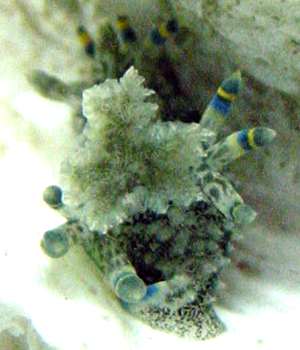
Dear Bill,
Thank you so much for your help in identifying our animal. I'm happy to know that we have made some form of contribution for this species. My husband, Sean, and I took some more pictures of him tonight, I'm sending three.
As far as I know, we've only seen two other species in our trips to the shore. One, we identified as the Ragged Sea Hare, and through this Forum, learned as much as we could about them. Actually, it wasn't long after reading the page on mass mortality that we encountered this. There were hundreds in water that was only a couple inches deep, forming circles, lines, and clumps, breeding. We were going to take pictures, but by the time we returned with the camera, it was over, they were gone. Over the next few days we found them washing in to shore. We brought four of the ones that were still alive home, but the next day they laid eggs and died. The other sea slug we found was an accident, we gathered some clumps of dead oysters to put in our tank, to give our blennies and other small fish something more to hide around, and one day after putting the oysters in the tank we spotted a sea slug, we never figured out what species, and we never saw him after that, all I can remember was that he had a pink head and a green body. I hope we find another like him so we can get pictures.
I didn't think about it at the time, but we did pull some bryozoans up with the Polycera hummi, they are arborescent, but I wouldn't know one species from another. Also, as a side note, I had no idea that this was such a rare thing, so I would like to clarify where he was found, the dock we were at is on Anna Maria Island, Manatee County, Florida. This way, if you're making some sort of record, it'll be more accurate.
Thank you again,
Karen Mudgett
anoksunamun@wildmail.net
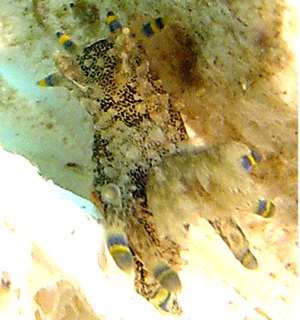
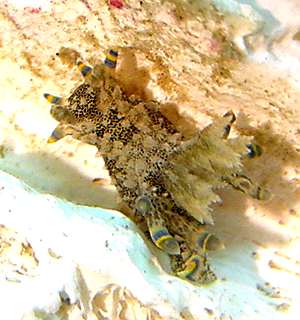
Dear Karen,
Glad to help and glad to get the observation. It's a good example of how the Forum brings together professional scientists and interested amateurs to our mutual benefit. It;s good to get photos from this angle because they clearly show that there are 2 anterior papillae in front of each rhinophore and 3 posterior ones on each side of the gills.
Thanks also for the photo in your separate message of its egg ribbon - another new bit of information
Best wishes
Bill Rudman
Egg-ribbon of Re: Polycera hummi
January 12, 2004
From: Karen Mudgett
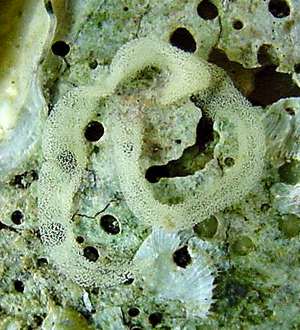
Dear Bill,
While attempting to find the sea slug to take the pictures I just sent, I also found this string of eggs. I'm sure they belong to it, there's no one else in the tank that would lay eggs like this. So now you have pictures of Polycera hummi, as well as it's eggs. However, based upon our experience with the Ragged Sea Hares, I'm now afraid that I will wake up tomorrow to find that it has died. I hope not, but I guess we'll just have to wait and see.
Karen Mudgett
anoksunamun@wildmail.net
Mudgett, K., 2004 (Jan 12) Egg-ribbon of Re: Polycera hummi. [Message in] Sea Slug Forum. Australian Museum, Sydney. Available from http://www.seaslugforum.net/find/11874Thanks Karen,
As you suggest, the eggs are another new bit of information. I'm afraid the cahnces of your animal staying alive long without its food are probably quite slim. Apart from anything else, the species of Polycera which live on arborescent bryozoans are quite fast growing animals which don't live for long. They have apparently adapted to living with these bryozoans which are themselves opportunistic organisms with are themselves fast growing and short-lived.
Best wishes
Bill Rudman
Polycera hummi from Florida
January 9, 2004
From: Karen Mudgett


Hello everyone,
We would like help with species identification, if possible. We're on the west coast of Florida [USA], near Tampa Bay. We found this sea slug along the side of a boat dock today, January 6, 2004. The water is no more than 3 to 5 feet deep, depending on tide. The bottom is mostly sand, with a bit of mud.
It's between half an inch and 3/4 of an inch long. On each side of his head there are 2 tube-like projections with 3 rings of color, 2 blue separated by yellow. Directly behind those, there are 2 more projections (1 on each side) without the color bands (antennae?). In the center, towards it's rear, there's a bushy clump (gills?) with 6 more of the color banded projections (3 on each side) below it. He also has tiny bumps all over him, although they seem to be mostly on the back half of him. When we first found him, he was curled up in a little ball and we thought it was going to be a Ragged Sea Hare, as its body colors and pattern were similar to the ones we found in the area at the end of last summer. But as I held him and he opened up, it became clear that this one was different.
I'd like to know what species he is, either scientific name or common name would be helpful, also any information you could share would be appreciated. We checked the Audubon Society field guide with no positive matches.
Thanks,
Karen
anoksunamun@wildmail.net
Mudgett, K., 2004 (Jan 9) Polycera hummi from Florida. [Message in] Sea Slug Forum. Australian Museum, Sydney. Available from http://www.seaslugforum.net/find/11853Dear Karen,
This is an interesting find. It is Polycera hummi, a species which only seems to have been reported twice since it was described in 1952. As far as I know, your photos are the first that have ever been published. It is known only from Florida, Sth Carolina and Nth Carolina, in the southeastern USA, but now we have a photo available it is probable that people will identify it from other parts of the warm water western Atlantic.
As it has been seen so rarely we know little about its biology, but there is one report (Eyster, 1980) of it on the arborescent bryozoan Bugula sp.. Most species of Polycera are associated with arborescent bryozoans and at times large populations of them can be found on their specific bryozoan, feeding, mating and laying egg ribbons. This is the second interesting species of Polycera we have had on the Forum from the southeastern USA recently. Last year, the first photos of Polycera chilluna from North Carolina were published showing that the eastern Atlantic species, Polycera aurantiomarginata is almost certainly the same species.
Photos of other sea slugs from your part of the world would be very welcome as we know suprisingly little about the ones found in your region.
Best wishes
Bill Rudman
